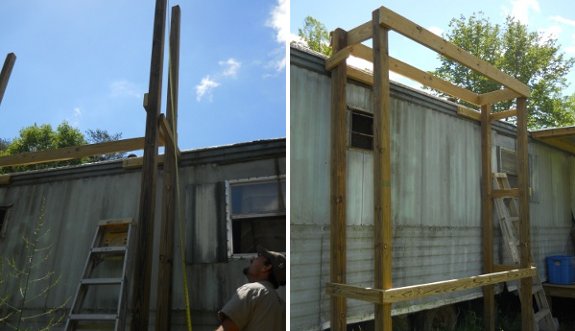
DIY solar panel tower

The plan is to mount our solar
cell panels on the top
and build drying racks for curing garlic and sweet potatoes towards the
middle area.
Want more in-depth information? Browse through our books.
Or explore more posts by date or by subject.
About us: Anna Hess and Mark Hamilton spent over a decade living self-sufficiently in the mountains of Virginia before moving north to start over from scratch in the foothills of Ohio. They've experimented with permaculture, no-till gardening, trailersteading, home-based microbusinesses and much more, writing about their adventures in both blogs and books.
Want to be notified when new comments are posted on this page? Click on the RSS button after you add a comment to subscribe to the comment feed, or simply check the box beside "email replies to me" while writing your comment.

If possible, put the panels on a frame that is connected to the structure with a hinge, so you can vary the angle of the panel over the year for maximum input. There is a handy calculator that can tell you the optimal angle over the course of the year. You'll need about 7-8 different angles (over a span of around 35 degrees) for an optimal position for every month of the year. I'm assuming that you'll set up the panels facing due south.
If you forget to do it by hand, then automate it. (more or less like the automated chicken coop door)
There are several ready-made solar trackers available, as well as plans to build your own.
A very simple one is to build a crank that rotates every 12 hours driven by a constant-speed electrical motor. This crank that lifts of lowers the panel via a connecting rod. This solution is simple, but runs the motor 24/7, which takes energy. You would still have to adjust the length of the crank and/or connecting rod monthly to keep in tune with the seasons.
A more energy efficient but still simple solution would be to use a stepper motor that only moves the panel a couple of times per day. This does require some "brains" to keep track of the time and run the motor at the predetermined time. And some power electronics to connect the brains to the engine. This could easily be made so that is knows to raise the panel differently depending on the season.
You'll get optimum power by building a real 2-axis tracker, that uses two light sensors to determine if the panel has to be moved around the horizontal or vertical axes. I'm sure there are plans for things like this online.
If you build something yourself, keep in mind that wind can exert quite a lot of force on a flat surface even if it hits at an angle, and the panels and mechanism have to be able to survive that. Try holding up a 4x8 sheet of plywood in heavy wind and you'll see what I mean.